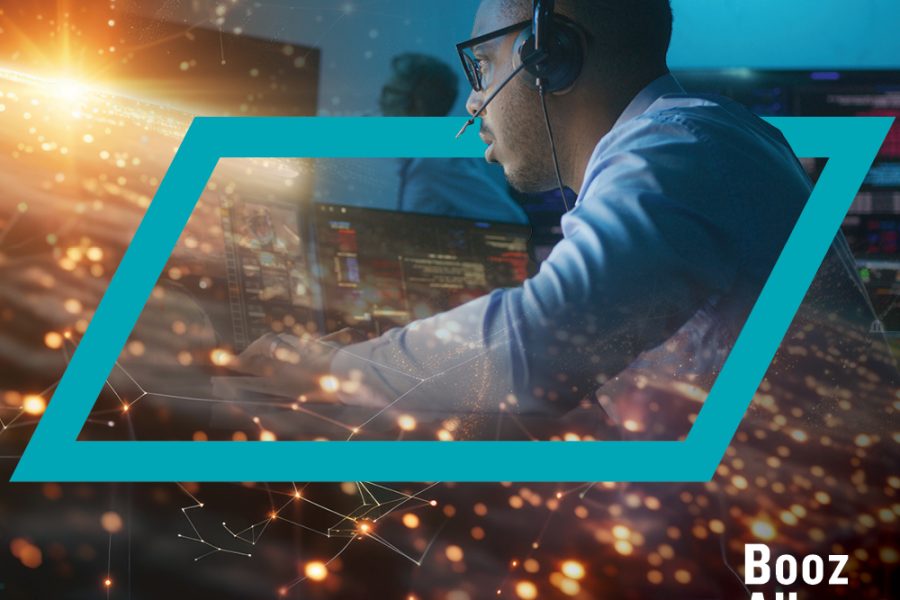Imagine you’re operating a network of ground sensors to track objects in orbit, and you’re successful in identifying a newly launched adversarial satellite. It was launched into very low Earth orbit (vLEO) at an altitude of 350 kilometers, and intelligence suggests it is a reconnaissance satellite with high maneuver capability.
Suddenly a strong solar flare occurs, heating Earth’s atmosphere and increasing the drag force on the satellite, causing it to drop into a lower orbit which you’re now scrambling to find.
“It’s already very challenging for satellite operators to fly their own satellites during a solar storm in LEO, so imagine how hard it is to keep track of a noncooperative maneuvering satellite in the same conditions,” says Matt Shouppe, a leader in Booz Allen’s space business. “Our adversaries know that when their satellites can’t be seen, that’s the best time to maneuver, deploy a covert payload, or perform some other operation they don’t want the U.S. to know about.”
Building on Open-Source Research
Having an accurate space weather forecast would help better predict the effects of drag, a game-changer for satellite operators. “But predicting what the sun is going to do 12, 24, or 48 hours from now is a long-standing challenge,” Matt says.
To better predict solar phenomena, weather professionals are turning to machine learning (ML). A major source is NASA’s Solar Dynamics Observatory (SDO), which images the sun every 12 seconds and makes extensive data available to train algorithms.
Open-source resources include not only data like SDO’s images, but also technologies to train them on. “Multiple researchers have been developing computer vision modeling techniques for solar phenomena. That allows today’s researchers to stand on their shoulders, so to speak,” says Dr. Jeremy Bundgaard, a Booz Allen physicist who advances the company’s space solutions. “Scientists can say, ‘What hasn’t yet been tried?’ and experiment.”
Using an Autoencoder for Machine Learning
Autoencoders present an intriguing option to speed up machine learning for solar events. These neural networks can compress and represent unlabeled data for unsupervised learning. Highly efficient, the models can detect anomalies and patterns rapidly.
“Our team adapted a transformer autoencoder training scheme to apply ML faster to publicly available data,” Jeremy says. The team has ingested the SDO Machine Learning Dataset—300,000 images taken over 10 years, in nine very high-resolution wave bands. The bands are indicative of specific chemical lines in the sun that correlate strongly with the radiation that will impinge the Earth.
“You can see sunspots and the flares and train the model on that imagery data to make a more accurate prediction of what the sun is going to do next,” says Jeremy.
“Open source keeps the door wide open for research,” says Ginny Cevasco, a senior vice president in Booz Allen’s national security business. “It gives scientists the opportunity to make better use of the data that’s already out there.”
Continual Improvement for Increased Accuracy
The approach is attractive partly because it can be made extensible, leveraged to continually grow. “Once you have the solar model, then anything that’s coincident in time for which you have good data, you can build in,” says Jeremy. “We can build pipelines—like DevOps pipelines, only they don’t degrade. Any additional high-quality data you have, as long as you have an overlap in time, will increase the accuracy.”
For example, if an organization launches a large constellation of satellites to measure atmospheric density with high precision or higher coverage, the team could immediately connect the autoencoder to that data stream and train on it as well.
Additional data such as solar indices, which measure the sun’s activity, and geomagnetic data can also be added. After all the data sources are onboarded, researchers can build a new model using the autoencoder. They can then correlate this model with models that measure the atmospheric drag which solar weather imposes on satellites.
“We can seed the resulting model into an atmospheric model, which in turn seeds an orbit determination model so we can more accurately predict a satellite’s position and velocity,” Jeremy says. That data can then be plugged in as one unified, information-rich source to make other solutions more precise—like Booz Allen’s i2S2, which is built on an open framework to pull in external space data applications.
“Optimizing an autoencoder to focus on one part of the overall drag model challenge shows the power of open-source innovation,” says Ginny. “When someone makes better use of the publicly available data, it helps space work better for everybody.”
Ginny Cevasco is a leader in the national security space business at Booz Allen.
Matt Shouppe is an expert in Space Situational Awareness (SSA) and Space Domain Awareness (SDA) at Booz Allen.
Dr. Jeremy Bundgaard is an AI and machine learning data science expert at Booz Allen.

